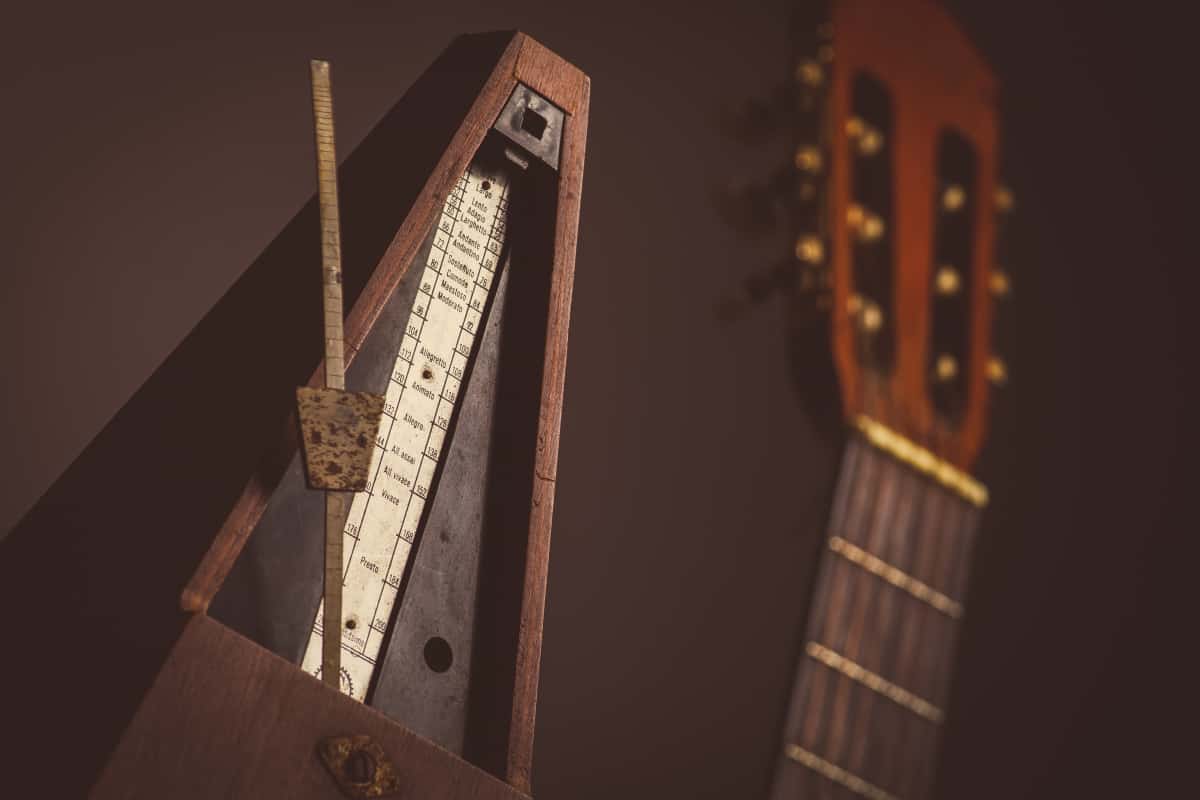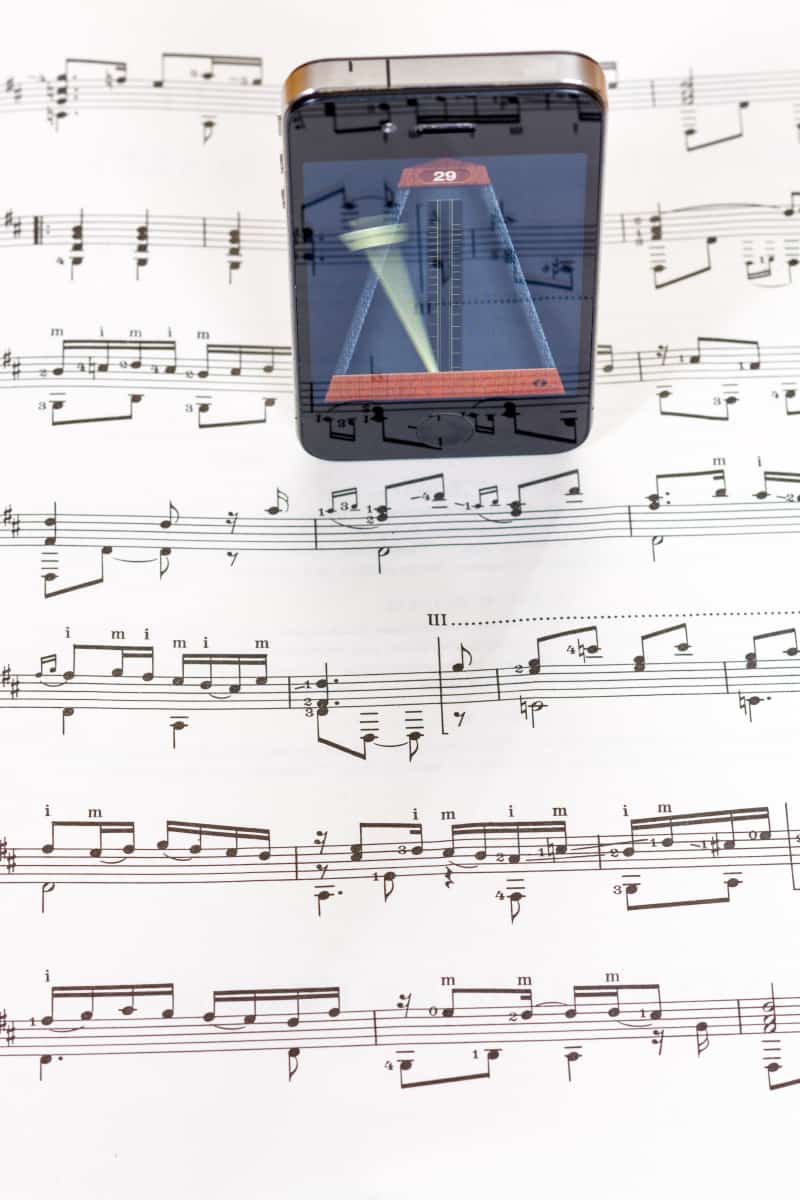How to Practice Guitar With a Metronome
One of the hardest things to do well on guitar is keeping time and having a steady rhythm. If you can't keep time, you won't be a very good player. This is a key area where many guitar players struggle. One way you can improve your timing and rhythm is with a metronome. Here's how to use this device during your practice routines.
Table of Contents
What is a Metronome?
A metronome is a device that helps you keep time by creating a constant beat. You can choose the tempo that you want to play at. It's a good idea to start with a slower rhythm and work your way up as your timing gets better.
The various speeds of the metronome make this device the ideal practice tool for increasing guitar speed and accuracy in all areas of playing, such as soloing, chords, and speed picking.

Getting Started
There's a ton of different metronomes on the market to choose from. You can use a physical device if you want or a digital one for your smartphone. They are simple to operate, and you'll be practicing with one in no time. Pick the tempo that you want to work with, and the metronome creates a constant click that you play along with.
Practicing with a Metronome – Scales
The easiest way to use a metronome is to practice your scales like the Pentatonic Minor, for example. Pick a slow beat on the metronome and play each note as the metronome clicks. The whole idea is to keep in time with metronome clicks, as this will improve your timing as you get better.
Only speed up the metronome when you're comfortable with the current beat and aren't making any mistakes when playing. Increase the speed of the device in small increments, and then see if you can play the scale again without making any mistakes. You can also practice note grouping within the scale, such as playing a group of three or four notes in time with the metronome.
Once you can play single-note scales, try a short solo to the beat of the metronome. This will take more practice but help you to keep time while soloing. Use the metronome to slow down licks and phases into a speed that you can manage. As you get better, try increasing the speed of the phrase to a higher level. The metronome helps you improve your accuracy with soloing.
Practicing with a Metronome – Chords
Rhythm guitar can be challenging, but the metronome can help in this area as well. Instead of playing single notes I a scale, Try a full chord progression or even one single chord. Try playing it in time to the click of the metronome.
Try different rhythms using the same chords, but keep in time to the click beat behind the music. As you get better, try increasing the tempo and trying more challenging chords like barre chords, for example. Work through your rhythm chops using the metronome to keep a constant beat behind you.

Practicing with a Metronome – Playing Songs
Find out the tempo of a song you want to learn and once you learn the parts, try playing the song along with the metronome. This will ensure you have a tight rhythm when playing the song. Once you can do this with the metronome successfully, try playing along with the music track. The constant click makes learning songs easier as you'll always be playing in time with the recording.
If you find the current speed of the song too fast, slow it down and try playing the track to a lower metronome speed. Once you cn master the slower speed, increase the tempo in small increments until you have the song mastered at the current recorded tempo.
Speed Building - Picking
One of the main uses of the metronome is to develop a faster picking speed. You can do this with scales, chords, or even single notes. Try playing a single note in time with the metronome speed. This is an excellent way to improve your speed by a wide margin as it makes you focus on keeping time to a constant click track behind your playing. Soloists can use a metronome to gain more picking speed for complex passages such as finger tapping, legato, fast scale runs, or sweep picking.
Slow it Down
The main thing to remember with a metronome is you want to start off slow at first. Don't try to pick at your maximum speed at first. You want to play comfortably at a given speed and only increase the metronome tempo once you have mastered your playing at a slower tempo.
One of the big mistakes players make is to try and play something too fast when their current playing level isn't ready for the increased speed. This leads to sloppy playing and constant mistakes as you're trying to force your fingers to play faster than they are currently capable of.
Take a passage of music and play it as slow as possible with the metronome and then slowly bring this up to a higher speed. This will enhance your rhythm a great deal as you'll learn to play it slow and then play it fast. Learning music slowly, and then you can build up to higher accurate speed.
Conclusion
A metronome is an excellent device to help you increase the speed in all areas of your guitar playing. It's the perfect tool for learning as it improves your timing and rhythm, which are key areas of guitar playing that all guitarists can improve upon.
If you use a metronome in your daily practice, you should see a marked improvement in not only your speed on guitar but accuracy as well. Make sure you start slowly before you add the speed. Always master something at a slow tempo and then increase the speed slowly. If you do this, you'll get a lot better no matter what area of your guitar playing that you seek to improve.

